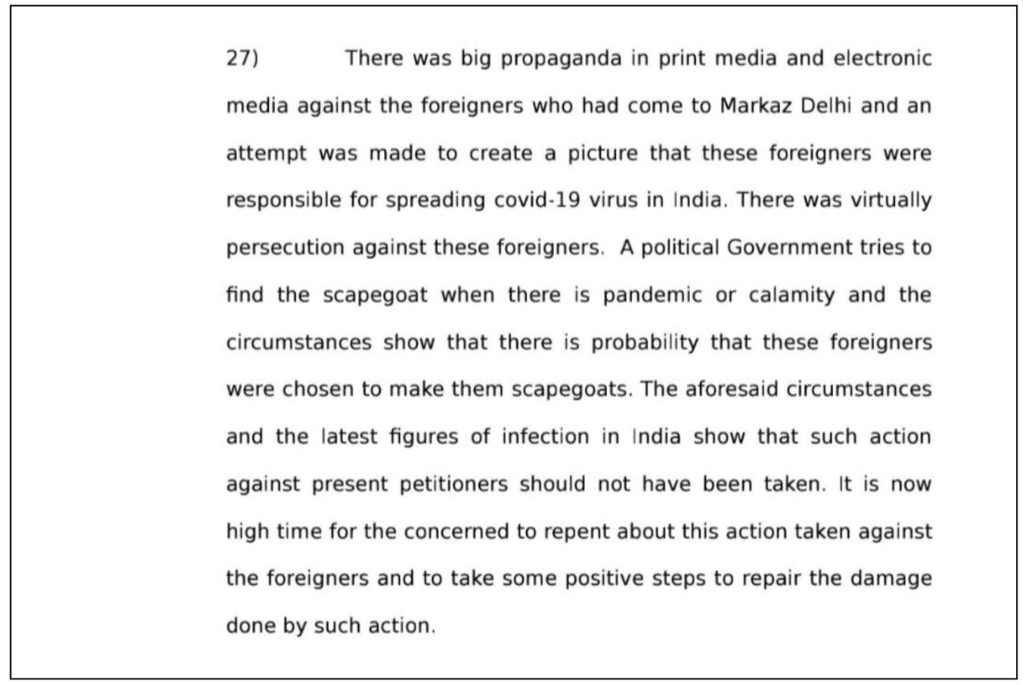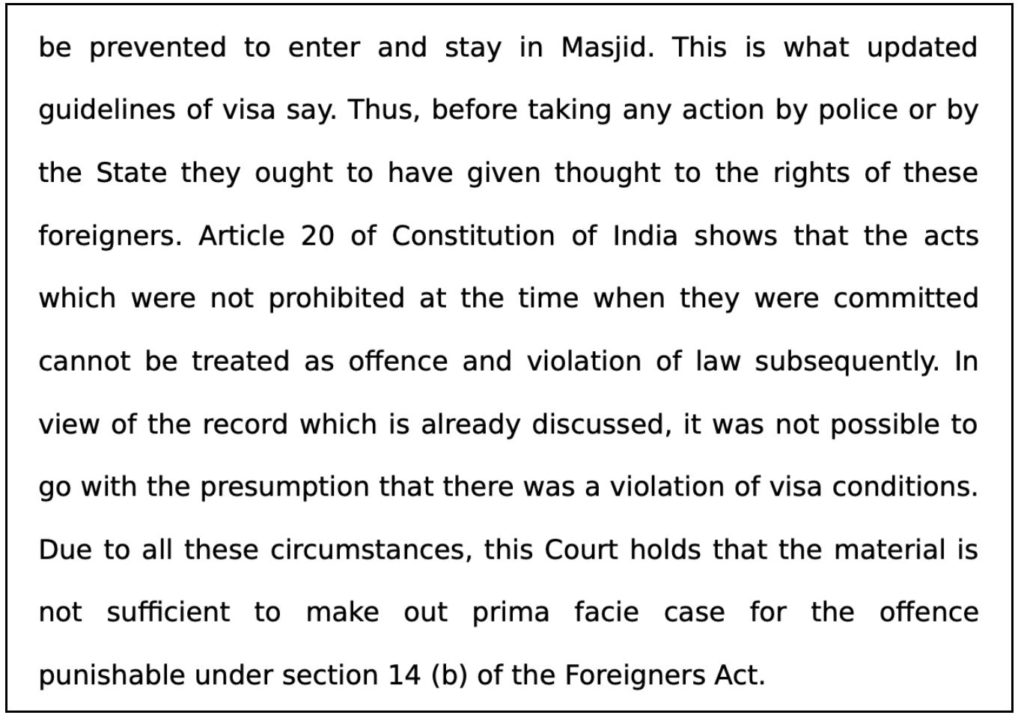Unlike the Press Council of India, there is no government-appointed regulatory body for the broadcast media in India. In the light of multiple court observations in recent times about unethical & hate-fuelled content, we look at the status of regulation of this sector.
In the past few months, the Supreme Court of India (SC) & other High Courts have come down heavily on TV news channels for broadcasting hate-fuelled or unethical programmes. These judgments & observations highlight the need for laying down clear guidelines and their effective implementation for TV channels or broadcast media. Let’s take a look at these observations and the current situation of TV channels’ regulation in India.
Judgments highlighting the need for effective regulation of TV channels
In the case of Konan Jodio Ganstone, et al. vs the State of Maharashtra, the Aurangabad bench of the Bombay High Court quashed FIRs against 29 foreign nationals of Tablighi Jamaat who were booked under various sections of IPC, Epidemic Diseases Act, etc. for alleged violations of visa norms. The court strongly criticized the Indian media by noting that “There was big propaganda in print and electronic media against the foreigners who have come to Markaz Delhi and an attempt was made to create a picture that these foreigners were responsible for spreading COVID-19 virus in India. There was virtually persecution against these foreigners.” Apart from foreign nationals, six Indian nationals and trustees of the Masjid were also booked under various abovementioned provisions.

The court was hearing petitions filed by foreign attendees of Tablighi Jamaat from Ivory Coast, Ghana, Tanzania, Djibouti, Benin, and Indonesia. The judgment examines the visa guidelines, health department notifications, and successive events of lockdown to conclude that the foreign nationals did not violate any visa norms and the other criminal charges against them were unfounded.

In the on-going case against Sudarshan TV, Firoz Iqbal Khan vs Union of India & Ors., the Supreme Court made important remarks in open court against content that promotes hatred. The news channel ‘Sudarshan TV’ broadcasted a program that claimed Muslim youth qualifying for recruitment to Indian Civil Services was another form of ‘jihad’. The judgment noted that it cannot allow such insidious comments in the name of freedom of the press that is used to vilify a particular community and disturb the harmony in the country. A three-judge bench headed by Justice D.Y. Chandrachud asked the government to file an affidavit seeking its response on the need to regulate electronic media.
In the backdrop of this, the News Broadcasters Association (NBA) filed an affidavit and requested the Supreme Court to make its Code of Ethics against broadcasting malicious, biased, and regressive content, be made applicable to all TV news channels by including it in the Programme Code of Cable TV Act. This would mandate all news channels, whether they are members of the NBA or not, to follow the Programme Code with proposed amendments. This was in response to an order by the apex court on 18 September 2020 to suggest measures to strengthen self-regulatory mechanisms in electronic media so that communal or derogatory content can be penalised and prevented.
In hearing Rakul Preet Singh’s plea against maligning a media campaign against her, the Delhi High Court directed the media channels to exercise restraint in their reports and follow the Programme Code of Cable TV Act and other guidelines, both statutory and self-regulatory. The Single Bench passed an interim order directing the News Broadcasters Association (NBA) to consider the present plea as a representation and expedite the process of redressal. Following this, in October, the News Broadcasting Standards Authority(NBSA) has found the news channels Zee News, Zee 24 Taas, Zee Hindustani, TimesNow, India Today, AajTak, India TV, News Nation, and ABP News at fault for their vilifying and slanderous reports linking film actor Rakul Preet Singh to drugs. The NBSA issued directives to the above-mentioned TV channels to remove the offensive content, whenever available. In a similar case of the events following the death by suicide case of Sushant Singh Rajput, the NBA directed three channels – Aaj Tak, Zee News, India TV, and News 24 – to observe restraint in reporting and apologise for insensitive reporting.
Regulations in Print and Broadcast Media
Existing legislations and their implications
In the past, the government has made a few attempts at regulating the media. The print media is regulated by the Press Council of India Act of 1978, which in turn established the Press Council of India (PCI) with the objective of “preserving the freedom of the press and to maintain and improve the standards of newspapers and news agencies”. PCI has the power to censure newspapers or news agencies for violations of standards of journalistic ethics or public taste, etc. It has the power to censure or admonish the offender after an inquiry. For the purpose of such inquiry, the PCI is empowered to summon and examine people and receive evidence and such an inquiry would be deemed to be a judicial proceeding, similar to a Civil Court under the Code of Civil Procedure 1908.
Other forms of news outlets, either electronic or digital do not come under the purview of PCI. The Cable TV Networks (Regulation) Act of 1995 was enacted to regulate the operation of cable television networks. According to the Act, all broadcasters have to comply with the ‘Programme Code’. As per the Programme Code, no programme should be broadcasted on television which offends against decency, contains an attack on religions or communities, or contains obscene, defamatory, deliberately false and suggestive innuendos and half-truths. The Act was amended in 2011 to bring all television channels under its purview. In the backdrop of this Act, in 2005, the Government of India established an Inter-Ministerial Committee (IMC) to investigate and adjudicate complaints about programmes in violation of Programme Code. The IMC can also take suo moto cognizance of any such violations.
After noting that this redressal mechanism already existed, the Supreme Court directed the government to raise awareness and formalise the process by creating a statuary framework under section 22 of the Cable TV Act, which lays down the provision that the government is empowered to make rules pertaining to the Programme Code for all kinds of broadcasting channels. However, this recommendation is yet to be implemented. Hence, currently, the statuary regulatory framework under the Cable TV Act is not sufficient.
Attempts at self-regulation among broadcasters
There have been some attempts at self-regulation in this sector. For non-news channels, the Indian Broadcasting Foundation was formed, which in turn established Broadcasting Content Complains Council (BCCC), an independent self-regulatory body in 2011. All non-news channels including entertainment, children’s channels, and others adhere to the suggestions of BCCC, despite some complaints, making it an over-arching self-regulatory body for all non-news channels.
Self-regulation scenario for News Channels
The self-regulation scenario for news channels is complex. The News Broadcasters Association (NBA) was established in 2008 as a private association of news broadcasters (comprising 26 broadcasters i.e. 77 news and current affairs channels) formed with the objective of “fostering high standards, ethics, and practices in need broadcasting”. NBA step up the National Broadcasting Standards Authority (NBSA) with the iconic former Chief Justice of India, Justice J S Verma, as its chairman and also issued a ‘Code of Ethics and Broadcasting Standards’ as a model for self-regulation to avoid content that is “malicious, biased, regressive, knowingly inaccurate, hurtful, misleading or aimed at willfully concealing a conflict of interest”.
The NBSA, however, only has jurisdiction over broadcasters that are members of the association. The NBSA does not have any statuary rights as it is a private association. Hence, its writ extends only to its members and the membership is voluntary. In case of complaints against members, the NBSA can warn, censure, or express its disapproval against the broadcaster and in some cases prescribe a fine up to one lakh rupees. A large number of national news channels have been members of the NBA since its inception in 2008. However, a few national channels and many regional channels are not members of the association and hence they are not governed by the Code of NBA.
Many such news channels formed a parallel body called the National Broadcasters’ Federation (NBF), with Arnab Goswami as its president. This association comprises three national channels as its members – Republic TV, Republic Bharat, and TV9 Bharatvarsh – along with over 45 regional channels.
OfCom model
In the context of TV channel regulations, United Kingdom (UK) offers a case in point – the Office of Communications (OfCom). It is a government-approved regulatory and competition authority for broadcasting, telecommunications, and postal industries. Like NBA, OfCom operates with fees from the industry itself but, unlike NBA, it was created by an Act of Parliament. Recently, OfCom has imposed a fine of 20,000 pounds on World Media Network Limited in relation to its service Republic Bharat (Hindi arm of Republic TV) for failing to comply with its broadcasting rules and ethics standards. World Media Network Limited is a UK licensee for the channel Republic Bharat. The decision outlines that a programme named ‘Puchta hai Bharat’ broadcasted on the channel on 06 September 2020 contained “uncontextualized hate speech”. The order noted that the comments made during the show promoted “hatred based on intolerance of Pakistani people based on their nationality alone”. Besides the fine, the regulatory body has directed the licensee to broadcast a statement or findings and issue an apology.


